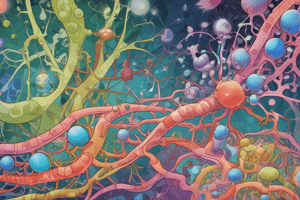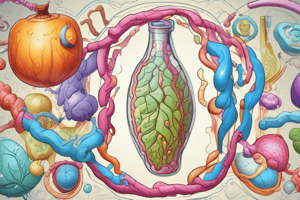Podcast
Questions and Answers
What is the fate of chylomicron residues after triglyceride breakdown?
What is the fate of chylomicron residues after triglyceride breakdown?
- They are stored in muscle tissue
- They are released into the bloodstream
- They bind to receptors in the liver and are taken in by endocytosis (correct)
- They are transported back to adipose tissue
What is the name of the condition resulting from inadequate uptake of chylomicron residues by the liver?
What is the name of the condition resulting from inadequate uptake of chylomicron residues by the liver?
- Type III hyperlipoproteinemia
- Familial lipoprotein lipase deficiency
- Type I hyperlipoproteinemia
- Familial dysbetalipoproteinemia (correct)
What is the purpose of beta-oxidation of fatty acids?
What is the purpose of beta-oxidation of fatty acids?
- To store fatty acids in adipose tissue
- To transport fatty acids to the liver
- To synthesize fatty acids
- To break down fatty acids into 2-carbon units (correct)
How are fatty acids with more than 12 carbons transported into the mitochondria?
How are fatty acids with more than 12 carbons transported into the mitochondria?
Where is carnitine primarily stored in the body?
Where is carnitine primarily stored in the body?
What is the purpose of the carnitine shuttle?
What is the purpose of the carnitine shuttle?
What is the name of the condition resulting from lipoprotein lipase or apoC-II deficiency?
What is the name of the condition resulting from lipoprotein lipase or apoC-II deficiency?
Where are fatty acids with 12 or fewer carbons transported from?
Where are fatty acids with 12 or fewer carbons transported from?
At what age should adults at average risk of coronary artery disease start having their cholesterol levels checked?
At what age should adults at average risk of coronary artery disease start having their cholesterol levels checked?
What is the enzyme responsible for adding CoA to fatty acids?
What is the enzyme responsible for adding CoA to fatty acids?
What is the optimal pH for lipase enzymes in the stomach?
What is the optimal pH for lipase enzymes in the stomach?
What is the primary function of apoB-48 in lipid synthesis?
What is the primary function of apoB-48 in lipid synthesis?
What percentage of ingested lipids are triacylglycerols (TAG)?
What percentage of ingested lipids are triacylglycerols (TAG)?
What is the fate of short- and medium-length fatty acids in the bloodstream?
What is the fate of short- and medium-length fatty acids in the bloodstream?
What is the primary function of lipoprotein lipase in triglyceride metabolism?
What is the primary function of lipoprotein lipase in triglyceride metabolism?
What is the function of essential fatty acids in the body?
What is the function of essential fatty acids in the body?
Where is cholesterol found in cell membranes?
Where is cholesterol found in cell membranes?
What is the product of glycerol uptake in the liver?
What is the product of glycerol uptake in the liver?
What is the primary function of apo-CII in triglyceride metabolism?
What is the primary function of apo-CII in triglyceride metabolism?
What is the consequence of a linoleic acid deficiency?
What is the consequence of a linoleic acid deficiency?
What is the function of lipids in the structure of plant perfumes?
What is the function of lipids in the structure of plant perfumes?
What is the destination of fatty acids released from chylomicrons in peripheral tissues?
What is the destination of fatty acids released from chylomicrons in peripheral tissues?
What is the primary function of acyl transferases in lipid synthesis?
What is the primary function of acyl transferases in lipid synthesis?
Which of the following is a fat-soluble vitamin?
Which of the following is a fat-soluble vitamin?
Flashcards are hidden until you start studying
Study Notes
Synthesis and Absorption of Lipids
- Fatty acids are activated by adding CoA via the enzyme acyl-CoA synthetase
- Activated fatty acids bind to monoacylglycerols, free cholesterol, and lysophospholipids via acyl transferases
- Short- and medium-length fatty acids are not esterified but enter the bloodstream directly and are transported to tissues by binding to albumin
- Resynthesized triglycerides and cholesterol esters are highly hydrophobic and are packaged into chylomicrons with phospholipids, free cholesterol, and apoB-48
- Chylomicrons are exocytosed from intestinal mucosal cells into the lymphatic circulation and from there into the general circulation
- Triglycerides in chylomicrons are broken down to fatty acids and glycerol by lipoprotein lipase on the surface of capillary endothelium
- Fatty acids can be taken up by muscle and adipose tissue cells or bind to albumin and be transported until taken up into the cell
- Glycerol is taken up by the liver and used in the synthesis of glycerol-3-phosphate, which can undergo glycolysis or gluconeogenesis via dihydroxyacetonephosphate
Beta Oxidation of Fatty Acids
- Beta-oxidation is a metabolic pathway in which fatty acids are catabolized into 2-carbon units in mitochondria, essential for meeting energy needs
- Fatty acids with 12 or fewer carbons can enter the mitochondria directly, while those with more than 12 carbons require the carnitine shuttle transporter system
Essential Fatty Acids (EFAs)
- EFAs are necessary for a healthy body and cannot be synthesized by the body
- Alpha-linolenic acid (an omega-3 fatty acid) and linoleic acid (an omega-6 fatty acid) are two important EFAs
- Foods containing EFAs include fish and shellfish products, flax seeds, hemp oil, soy oil, canola oil, chia seeds, pumpkin seeds, sunflower seeds, leafy vegetables, and walnuts
Functions of Lipids
- Lipids provide high energy storage
- They create waterproof layers in plants and form an insulating layer on nerve cells (myelin)
- They create a shock-absorbing layer on the bodies of animals
- Cholesterol is found in cell membranes between phospholipids
- Steroids are found in the structure of estrogen, testosterone, and cortisol
- Fragrance is found in the structure of plant perfumes
- Fat-soluble vitamins A, D, E, and K are essential for various bodily functions
Studying That Suits You
Use AI to generate personalized quizzes and flashcards to suit your learning preferences.




